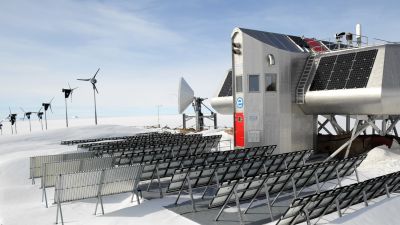
Running on Renewable Energies
Two of the most omnipresent features of Antarctic weather (during the Austral summer) are the wind and the sun. Two renewable sources that provide free energy to the “zero emission” Princess Elisabeth Antarctica.

A Mix of Renewable Energy Sources
While the sun never sets in Antarctica for one half of the year, it never rises for the other half. This means that, in order to function properly during the Antarctic winter, the Princess Elisabeth Station needed a second source of energy that would be available all winter long.
The katabatic winds on the Antarctic continent provided the answer to that issue, as the wind gusts from the plateau are as fierce in the winter as they are in the summer.

Nine Wind Turbines
Along the ridge of the Princess Elisabeth Station are nine wind turbines, installed by the IPF crew to complement the solar installations.
Each of the wind turbines is designed to withstand the most vicious storms on Earth. The blades of the wind turbines can close down in the event of a storm, thus reducing the rotating speed in order to prevent any damage from occurring to the wind turbine.
Two Breeds of Solar Panels

Photovoltaïc Solar Panels
These solar panels cover most of the surface of the “zero emission” Princess Elisabeth Station and the roof of the technical spaces. The panels feed the smart grid of the station with electricity, while any excess production is stored in the batteries.

Thermal Solar Panels
Located on one side of the roof of the Princess Elisabeth Station, the thermal solar panels are used to melt the snow and heat the water to be used in the station's bathrooms and kitchen.

Batteries Room
The energy-producing solutions implemented at the Princess Elisabeth Station are incredibly efficient, so much so that solutions had to be foreseen for storage of any excess energy.
A room full of classic lead-acid batteries enables the station to store energy for times when demands exceeds the current energy production.

Backup Solutions
While the renewable energy systems that power the station are reliable and continuously checked, even in the harsh conditions of Antarctica, two generators were installed for security and backup. They are also used to provide scheduled full load cycles which are part of the battery bank life performance.
In the future, the station's engineering team plans to install hydrogen fuel cells as an additional intermediary backup system.
